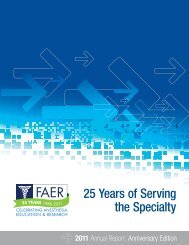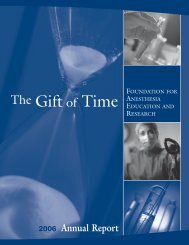2010 MSARF Symposium Participants - Foundation for Anesthesia ...
2010 MSARF Symposium Participants - Foundation for Anesthesia ...
2010 MSARF Symposium Participants - Foundation for Anesthesia ...
You also want an ePaper? Increase the reach of your titles
YUMPU automatically turns print PDFs into web optimized ePapers that Google loves.
Student Name: Naveen Reddy<br />
Host Department: The Children's Hospital of Philadelphia<br />
Primary Mentor Name: Gordon Barr, PhD<br />
Additional Mentors: Ron Litman, DO<br />
Title of Research Project: Immune system correlates in morphine withdrawal of infant rats: a flow cytometric<br />
analysis<br />
Traditionally, research has concentrated on the neuron mediated effects of opiates. Within the past decade, some of the<br />
focus has shifted to non-neuronal effects. Here we focus on the interplay between morphine withdrawal and the infant rat<br />
immune system. While there has been increased research in recent years on how the immune system influences<br />
dependence and tolerance to drugs such as morphine, it is not known how those same processes work in infants. In the<br />
infant, many of the mechanisms of inflammation, including immune responses, are not yet mature. In adult rats chronic<br />
morphine withdrawal induced upregulation of glial fibrillary acidic protein (GFAP) and tumor necrosis factor alpha<br />
(TNFa) in the periaqueductal gray (PAG). It is not know whether there is a similar response in infants. We will<br />
investigate the level of immune system activation under eight experimental conditions: saline, morphine,<br />
lipopolysaccharide (LPS), and LPS and morphine injections combined with either saline or naloxone to precipitate<br />
withdrawal. LPS is a bacterial cell wall protein that activates toll like receptors (TLR) of the mammalian innate immune<br />
system. Flow cytometry is used to quantitatively assess the differences in specific cell populations between experimental<br />
groups. We are primarily looking at the levels of astrocytes and microglia by using fluorescent antibodies against GFAP<br />
and CD11/CD45 respectively. We also use antibodies against TNFa to see which cells, if any, are expressing this<br />
cytokine in infant rats. All assays are done on freshly dissected, complete spinal cords. Results: experiment ongoing.<br />
Student Name: Damoon Rejaei<br />
Host Department: University of Wisconsin-Madison<br />
Primary Mentor Name: Robert Pearce, MD, PhD<br />
Title of Research Project: Effects of Novel Intravenous Fluorocarbon-Based Emulsions of Sevoflurane in Canines<br />
Intravenous delivery of fluorinated volatile anesthetics leads to rapid anesthetic induction by eliminating the lung<br />
equilibration time, and to rapid recovery following elimination through the lungs. This mode of delivery could be<br />
particularly beneficial <strong>for</strong> brief and intense stimuli. However, our previous canine investigations using novel intravenous<br />
20% v/v sevoflurane solubilized by fluorinated surfactant polymer resulted in profound histamine release. We<br />
hypothesized that adding glucose moieties to the surfactant molecules would decrease their immunogenicity. We<br />
investigated the cardiovascular, immunogenic, and anesthetic effects of three re-<strong>for</strong>mulated intravenous sevoflurane<br />
emulsions in beagles: M1F13 (n=3, no glucose), G1M1F13 (n=2, one glucose) and G3M1F13 (n=1, 3 glucose). All<br />
emulsions produced general anesthesia. However, dogs exhibited adverse clinical signs which worsened with increasing<br />
number of glucose molecules (eg. urticaria, vomiting, scleral injection, hematochezia); only 1 dog was administered<br />
G3M1F13 due to the severity of the reaction. Mean blood pressure decreased from 124 and 150 mm Hg pre-injection to a<br />
minimum of 32 and 74 mm Hg approximately 7 minutes following injection of M1F13 and G1M1F13, respectively.<br />
Activated prothrombin times were increased in G1M1F13 dogs post-injection versus control samples. Pre- and postinjection<br />
(5, 10, 14, 21, 28 days) plasma histamine, IgE, IgM and complement levels are pending. Given the small sample<br />
size, no statistical analysis was done. Our data suggest an anaphylactic or anaphylacotoid hypersensitivity reaction<br />
entailing release of histamine, prostaglandins, and heparin. We conclude that bolus administration of these intravenous<br />
sevoflurane polymers are unsuitable <strong>for</strong> inducing general anesthesia in dogs due to side effects.<br />
23





